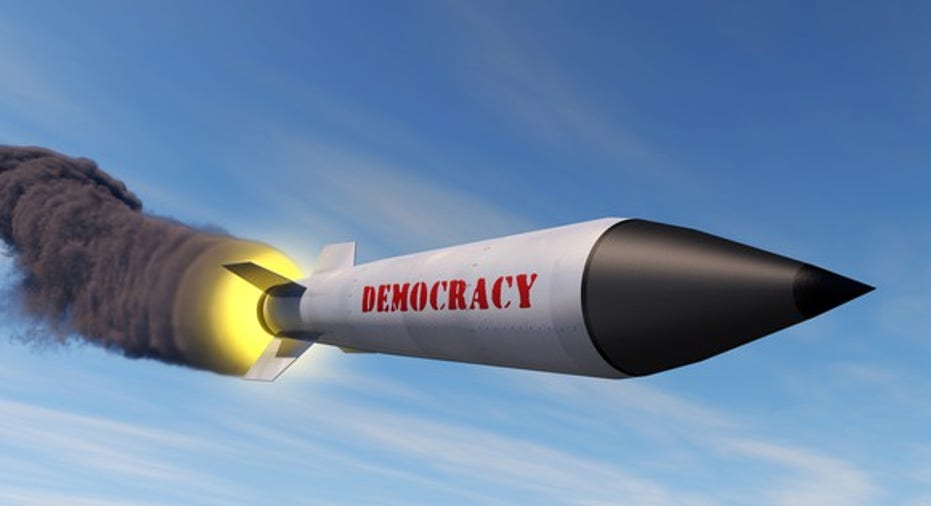Air Force Seeks New Nukes -- but Who Will Build Them?

Nukes for freedom? Image source: Getty Images.
America has long been called the arsenal of democracy -- but lately, that arsenal has been showing its age.
Take its "ground-based strategic deterrent." This euphemism describes America's land-based intercontinental ballistic missile (ICBM) force, which currently comprises 450 LGM-30 Minuteman III nuclear missiles. Guided by 20-year-old flight systems, these 40-year-old missiles are housed in 50-year-old silos spread across Montana, Wyoming, and North Dakota. And according to a recent report by 60 Minutes, the control systems that run those silos depend on vintage 1980s-era floppy disks.
Time for a systems reboot
If that all sounds a bit archaic to you, well, the U.S. Air Force agrees. The Minuteman III generation of ICBMs is only expected to remain operational through 2030. And given how long it takes the Pentagon to develop new weapons systems, that means the Air Force has to start thinking about upgrading its ICBMs right about... now.
Last week, the Air Force took the first step in that process, releasing a request for proposals to replace the Minuteman III ICBM with an entirely new weapons system -- including not just the ICBMs themselves, but new launchers and command and control systems as well.
The players
Few details on the RFP are available at this time, but according to the defense experts at Jane's, at least three big defense contractors are expected to bid on the deal: Boeing (NYSE: BA), Lockheed Martin (NYSE: LMT), and Northrop Grumman (NYSE: NOC).
That's logical. Boeing, after all, was the prime contractor on building the Minuteman III in the first place, Lockheed did the missile's command and control systems, while Northrop won a contract to support its ground subsystems last year. One can also assume Aerojet Rocketdyne (NYSE: AJRD) will be bidding for at least a piece of the contract. Aerojet has already offered to upgrade the launch engines on the Minuteman fleet, and won't want to be left out of a wholesale upgrade.
The timeline
So how big could this contract become, and when can we expect to learn the winner? Let's tackle those questions in reverse order.
According to the Air Force, bids are due next month. By Oct. 1, 2017, it should award one or two "cost-plus" development contracts, that will run for about three years, before picking a final winner. Once that winner has been determined, deployment of the new missiles still won't begin for another decade -- toward the end of the 2020s, or just in time to replace the retiring Minutemen IIIs. Once deployed, the new ICBMs will be expected to serve as America's ground-based strategic deterrent through about 2075.
So right away you can see that this is going to be a long process. Whichever company wins the contract, profiting from it will take some time.
Luckily for the winner, the money should be worth the wait. Defense Industry Daily estimates that replacing the ICBM force will cost about $350 billion over 10 years, rising to as much as $1 trillion over 30 years.
$1 trillion dollars -- and counting
Final note: If the numbers being floated about the size of the ICBM program aren't enough to entice you, consider this: The Air Force is also preparing to fund a separate, $20 billion to $30 billion program,to develop a new nuclear-tipped cruise missile for its bombers, the Long Range Stand-Off (LRSO) weapon. Once again, Boeing, Northrop, and Lockheed are all bidding, with Raytheon (NYSE: RTN) also in the mix. Paired with Northrop Grumman's even more expensive B-21 stealth bomber program (valued at $79 billion or more), LRSO would form the new second leg of the nation's nuclear force -- the part that gets launched from strategic bombers -- and put another $100 billion or so up for grabs.
And of course, there's the third leg, the Ohio Replacement class of nuclear missile submarines, estimated to cost another $79 billion or more. In total, the numbers being bandied about for America's nuclear rearmament program add up to a staggering $500 billion to $1.2 trillion opportunity for the eventual winners.
Now all Congress has to do is find enough money to pay for all this in the defense budget.
A secret billion-dollar stock opportunity The world's biggest tech company forgot to show you something, but a few Wall Street analysts and the Fool didn't miss a beat: There's a small company that's powering their brand-new gadgets and the coming revolution in technology. And we think its stock price has nearly unlimited room to run for early in-the-know investors! To be one of them, just click here.
Fool contributorRich Smithdoes not own shares of, nor is he short, any company named above. You can find him onMotley Fool CAPS, publicly pontificating under the handleTMFDitty, where he's currently ranked No. 301 out of more than 75,000 rated members.
The Motley Fool has no position in any of the stocks mentioned. Try any of our Foolish newsletter services free for 30 days. We Fools may not all hold the same opinions, but we all believe that considering a diverse range of insights makes us better investors. The Motley Fool has a disclosure policy.



















